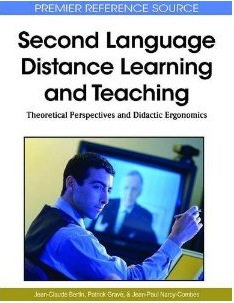March 2011 – Volume 14, Number 4
Second Language Distance Learning and Teaching:
|
|||
| Author: | Jean-Claude Bertin, Patrick Gravâe, and, Jean-Paul Narcy-Combes (2010) |  |
|
| Publisher: | Hershey, PA: Information Science Reference | ||
| Pages | ISBN | Price | |
|---|---|---|---|
| 391 Pages | 978-1615207077 (Hardcover) | $180.00 U.S. | |
Second Language Distance Learning and Teaching: Theoretical Perspectives and Didactic Ergonomics (hereafter referred to as Second Language Distance Learning and Teaching) is a comprehensive text that takes a hybrid approach to distance education. The book is written by Jean-Claude Bertin (Full Professor of English language learning and teaching at University of Le Havre, France), Patrick Gravâe (psycho-sociologist and Senior Lecturer in educational sciences at University of Le Havre, France), and Jean-Paul Narcy-Combes (Full Professor of English language learning and teaching at Sorbonne nouvelle – Paris 3 University, France).
By combining interactionist and systemic theories, along with Morin’s (1990) concept of complex thought, Bertin et al. have developed a model that is well-grounded yet remains distinct from its counterparts. The authors base their model on a view of language as not only interactive, but also as both intrapersonal and interpersonal. They claim this is distinct from the approaches applied to most distance education courses where the focus is on only one of these theoretical underpinnings of second language acquisition. Without making overly grand claims about the value or advantages of e-learning, Bertin et al. manage to convince the reader of the approach’s relevance for second language studies. Based upon a 5-pole model that includes learner, teacher, language, context, and technology, the book focuses on how CALL (Computer Assisted Language Learning) can be used to enhance language instruction.
After strongly situating the model as didactic ergonomic, the authors devote a chapter to each of the five poles mentioned above. They take great care in detailing each one individually, as well as citing how the poles relate to and interact with one another. Emphasis is also placed on the dynamic nature of the poles and the need for practitioners to take stock of each pole’s relation to their specific learning environments for potential implications to curriculum design. Such adaptability is seen as crucial for successful implementation of the model. Fortunately for the reader, a myriad of figures is used to illustrate these somewhat complex linkages. Thus, the text is brought to life, especially for the visual learner, with the relationships among the five respective poles being made clear.
Second Language Distance Learning and Teaching also includes several useful tables covering topics such as the following:
- A comparison of analytic and systemic theories
- A synthesis of second language learning processes and theories
- An overview of the role of individual differences in second language learning
- Teacher postures (i.e. “a dominant way of apprehending events, largely conditioned, which may result in an actual physical way of behaving”)
- A reference list of CALL literature that identifies different aspects of technology
- The functions and scope of learner support services
- Macro-tasks and micro-tasks for Task-based Language Teaching (TBLT) and their respective roles in online learning environments
- A list of guiding principles for curriculum designers with suggestions on how to solve common dilemmas
- An example of a learner-designed distance course from the University Sorbonne Nouvelle in France.
Bertin et al. also touch on the hesitancy of faculty and researchers alike in adopting new technologies, citing the all too familiar “waste of time and efficiency” and “energetic and material cost” as leading reasons. They then warn against this line of thinking, stating that without progress one is left recycling the same pedagogical model indefinitely. Rather than furthering this cyclical philosophy, the authors advocate for the acceptance of new technologies in computer-mediated language learning.
While by no means a light reading, Second Language Distance Learning and Teaching is chock full of useful reference information. And while a background in distance education would prove useful when charting the course of its more technical chapters, by and large the material remains navigable to novices, as well. In fact, due to the authors’ methodical approach to the topic, this book would be a practical resource for second language professionals in general. So whether a language teacher is interested in developing a hybrid course, a curriculum developer is charged with the task of converting a face-to-face course to an online format, or colleagues need convinced of the potential distance education holds for language instruction, this book provides the solid foundation necessary for success with one’s endeavors.
Again, this book is not for the weary or for those who want a simple step-by-step guide to developing an online course. However, its forward-thinking nature is unique as is its application of distance education to second language learning. If the reader is serious about grounding his or her understanding of distance learning environments and content on designing online language-based courses that will be pedagogically effective, then Second Language Distance Learning and Teaching should not be a disappointment.
Reviewed by
Sara Randrianasolo
Purdue University
<srandria![]() purdue.edu>
purdue.edu>
|
© Copyright rests with authors. Please cite TESL-EJ appropriately.
Editor’s Note: The HTML version contains no page numbers. Please use the PDF version of this article for citations. |

